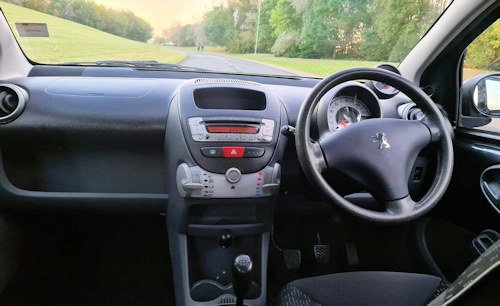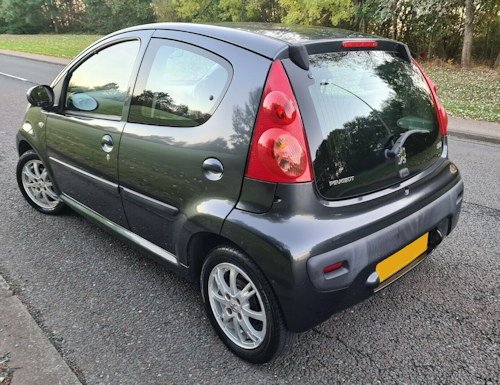Peugeot 107
 |
|
|
Make |
Peugeot |
|
Years of production |
2005 - 2014 Phase 1: 2005 - 2008 |
|
Production |
822 644 built |
|
Classroom |
motor car |
|
Assembly plant (s) |
Kolin |
|
Engines |
Petrol 1.0 VTi 68 |
|
Engine position |
Front |
|
Displacement |
From 998 to 1,398 cm 3 |
|
Maximum torque |
93 to 130 Nm |
|
Gearbox |
Manual 5 reports |
|
Unloaded weight |
From 790 to 890 kg |
|
Maximum speed |
154 to 157 km / h |
|
Acceleration |
0 to 100 km / h in 12.3 to 15.6 s |
|
Mixed consumption |
4.1 to 4.6 L / 100 km |
|
Emission of CO 2 |
99 to 109 g / km |
|
Bodywork (s) |
Sedan unibody 3 door, 4-seater |
|
Coefficient of drag |
0.337 |
|
Length |
3,435 mm |
|
Width |
1,630 mm |
|
Height |
1,468 mm |
|
wheelbase |
2,340 mm |
|
Trunk volume |
From 130 to 140 dm 3 |
The Peugeot 107 is an urban car for four people with three and five doors marketed since June 2005 by the French manufacturer Peugeot . It is replaced by the Peugeot 108 in 2014.
History
The decision to produce entry-level cars was made on July 12, 2001, when the presidents of Toyota and PSA Peugeot Citroën , Fujio Cho and Jean-Martin Folz , decided to produce a small car in common to share development costs.The Citroën C1 , Peugeot 107 and Toyota Aygo are built in the TPCA plant , a joint venture between PSA Peugeot Citroën and Toyota in Kolín in the Czech Republic . These three vehicles were world-premiered at the Geneva Motor Show and launched in series on February 28, 2005. They were available from 2005 to 2014 and replaced by the second-generation Citroën C1 and Toyota Aygo and the Peugeot 108 ..
The front headrests are integrated, the rear windows are compass on the five-door model, and fixed on the three doors.The tailgate is a simple black tinted window in its lower part (to visually support the Peugeot 107 logo and lion, as well as the windshield wiper ).
The Peugeot is distinguished by its almond front lights and large air grille located under the grille. During the first restyling, the shape of the vents on the 107 sees its angles more pronounced, to follow the stylistic evolution of the cousin 207. During the second restyling of 2012, the Peugeot 107 adopts the new Peugeot style driven by the SR1 and HR1 : floating grille, new lion logo in the middle, new LED shields.

The petrol engine, which benefits from Toyota's know-how, is equipped with a VVT-i system of variable timing of the continuous distribution, managed by computer (according to the acceleration, the load ...). The engine has only three cylinders. At Toyota, this engine is itself taken from the "small models" section of the brand, that is to say the Daihatsu brand . It will be found on many models of Japanese cars of small size, and even on a future Subaru strongly resembling an Opel Agila.
Four people can be accommodated, and it is equipped in series for Western Europe with an ABS, two frontal airbags and a stability control system in curve called CSC (but which is not not the optional ESP offered). The 107 also earned 4 stars in Euro NCAP crash tests for adults (3 for children), with a total score of 26 points out of 37, and it gets 2 stars for pedestrian protection.
The two gearboxes are:the 5-speed manual transmission on all models;the optional 5-speed robotic manual gearbox, available only for the 1.0i petrol model.The robotic manual can also work as an automatic.
Braking is provided by ventilated discs with single-piston calipers floating in the front (which competitors do not always have) and simple drums at the rear.The course of the vehicle in braking supported is very correct, even if the reduced weight of the structure tends to make the ABS quite picky.

Technical
-
Peugeot 107 technical details (2005-2014)
1.4 HDi 55
1.0 68
Engine
4 cylinders
3 cylinders
Displacement
1398
998
Max power
54 hp at 4000 rpm
68 hp at 6000 rpm
Max torque
130 Nm at a speed of 1750 rpm
93 Nm at a speed of 3600 rpm
Gearbox
BVM5
BVA5
Max speed
154
157
157
0- 100 km / h
15.6
12.3 to 13.7
14
Consumption (in L / 100 km)
4.1
4.3 to 4.5
4.5 to 4.6
CO 2 emissions (in g / km)
109
99 to 103
104 to 107
